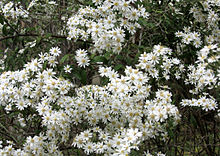- Olearia phlogopappa
-
Olearia phlogopappa 
Scientific classification Kingdom: Plantae (unranked): Angiosperms (unranked): Eudicots (unranked): Asterids Order: Asterales Family: Asteraceae Tribe: Astereae Genus: Olearia Species: O. phlogopappa Binomial name Olearia phlogopappa
(Labill.) Benth.[1]Synonyms Aster phlogopappus Labill.
Olearia gunniana (DC.) Hook. var. gunniana
Olearia gunniana var. phlogopappa (Labill.) Hutch.
Olearia gunniana (DC.) Hook.Olearia phlogopappa (Dusty Daisy-bush) is a species of flowering plant in the family Asteraceae.[2] It occurs in open forest, woodland, heath and coastal shrubland in New South Wales, Victoria, and Tasmania.[3][4]
Contents
Description
Oleraia phlogopappa grows to between 0.3 and 3 metres in height.[5] The leaves are quite variable, but are usually grey-green with minute hairs on the underside which impart a whitish or yellowish appearance.[5] The leaf margins are often bluntly toothed.[5] White, pink or mauve "daisy" flower heads around 20-25 mm in diameter are mainly produced in spring and early summer.[3]
Taxonomy
The species was first formally described by Jacques Labillardière in 1806 in Novae Hollandiae Plantarum Specimen and named Aster phlogopappus.[1] In 1836 the species was transferred to the genus Olearia by Augustin Pyramus de Candolle in Prodomus.[1]
There are 6 varieties which are currently recognised:[1]
- O. phlogopappa var. angustifolia (Hook.f.) W.M.Curtis
- O. phlogopappa var. brevipes (Hook.f.) W.M.Curtis
- O. phlogopappa var. flavescens (Hutch.) J.H.Willis
- O. phlogopappa var. microcephala (Hook.f.) W.M.Curtis
- O. phlogopappa (Labill.) DC. var. phlogopappa
- O. phlogopappa var. salicifolia (Hook.f.) W.M.Curtis
Cultivation
The species withstands moderate frost and drought, but prefers moist conditions and a well drained soil in a sunny or partially shaded position.[3] Pruning is required to stop plants becoming spindly.[3] Cuttings are the usual method of propagation as seed may be unreliable.[3]
Cultivars
A number of cultivars are commercially available including:[1][6]
- 'Blue Gem'
- 'Brevipes'
- 'Cana'
- 'Combers'
- 'Comber's Blue'
- 'Comber's Pink'
- 'Nyman's Splendens'
- 'Pink Gem'
- 'Salicifolia'
- 'Sawtooth'
- 'Splendens'
- 'Splendens Blue'
- 'Splendens Lavender'
- 'Splendens Pink'
- 'Tournaig Titch'
Another cultivar, 'Havering Blush', is a hybrid between Olearia phlogopappa and Olearia lirata.[6]
References
- ^ a b c d e "Olearia phlogopappa". Australian Plant Name Index (APNI), IBIS database. Centre for Plant Biodiversity Research, Australian Government, Canberra. http://www.anbg.gov.au/cgi-bin/apni?TAXON_NAME=Olearia+phlogopappa. Retrieved 2009-06-28.
- ^ "Olearia phlogopappa (DC.) Benth.". PlantNET - New South Wales Flora Online. Royal Botanic Gardens & Domain Trust, Sydney Australia. http://plantnet.rbgsyd.nsw.gov.au/cgi-bin/NSWfl.pl?page=nswfl&lvl=sp&name=Olearia~phlogopappa=. Retrieved 2009-06-28.
- ^ a b c d e "Olearia phlogopappa". Australian Native Plants Society (Australia) - ANPSA. http://asgap.org.au/o-phl.html. Retrieved 2009-06-28.
- ^ "Gippsland Vegetation Types: Ecological Vegetation Classes (EVC’s)". Department of Primary Industries (Victoria). http://www.dpi.vic.gov.au/dpi/vro/wgregn.nsf/0d08cd6930912d1e4a2567d2002579cb/d7df67e863bf94d8ca2574ef001a3cfb/$FILE/EVC%20876%20%20%20Sprayzone%20Coastal%20Shrubland.pdf. Retrieved 2009-06-29.
- ^ a b c Costermans, L. (1981). Native Trees and Shrubs of South-eastern Australia. Australia: Rigby. ISBN 072701403x.
- ^ a b "'Olearia". Horticultural Database. Royal Horticultural Society. http://www.rhs.org.uk/rhsplantfinder/plantfinder2.asp?crit=Olearia+and+phlogopappa. Retrieved 2009-06-29.
Categories:- Asterales of Australia
- Flora of New South Wales
- Flora of Tasmania
- Flora of Victoria (Australia)
- Olearia
Wikimedia Foundation. 2010.
